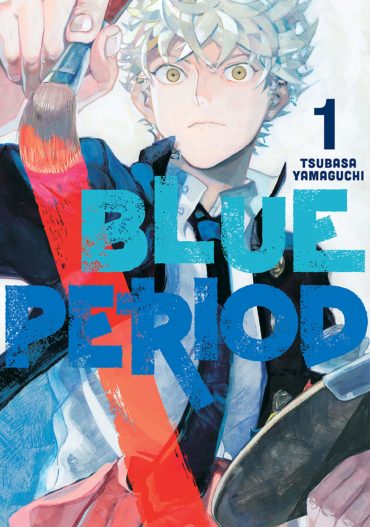Blue Period Volume 1 Review
‘Art is fun, you know. And those who are true to themselves make truly great art. Because art is a language without words.’
Yatora Yaguchi (Yakkun to his friends) is at ‘that’ stage of his high school life when he has to make a decision soon about which university he’s going to apply to. In the meantime, he hangs out with his mates, watches football, likes a beer and a smoke, scores good grades in class, everything’s fine…except he feels that something indefinable yet vitally important is missing. He signs up for the ‘Elective Art’ in school which is seen as something of a skive. But one day, coming upon a painting by one of the upper class students in the art room, he’s transfixed – and suddenly, his easy-going everyday is no longer satisfying. Inspired, he paints a local street scene using shades of blue – and suddenly he knows what he wants to do: create art. He’s moved to tears when other people admire his work. He joins the art club, determined to learn all he can about what it takes to become an artist.
The title, Blue Period aptly evokes the period in Pablo Picasso’s early career when everything he painted was saturated in blue. This manga comes to the West garlanded with the accolade of winner of the 2020 Manga Taisho Grand Prize. It also makes a fascinating comparison with Blank Canvas, Akiko Higashimura’s five-volume autobiographical manga. Higashimura manages to slip in the details of her early art training in an entertaining way (showing, not telling) whereas Blue Period is rather less subtle. It treads a slightly uneasy line between delivering awkward info-dumps (mostly by the art teacher to her new student) on the colour wheel (in black and white!), perspective, shading, painting with oils etc. – and its core story of a young man’s awakening to his innate artistic gift. This manga soars when it depicts Yatora’s visceral excitement on picking up a paintbrush and letting his imagination loose to wander freely. It also holds the attention (although it’s early days yet) in introducing him (and us) to the other art students in the school art club who are not the kind of people he usually hangs out with. They – mostly girls – regard him with suspicion, nicknaming him ‘that delinquent’ because of his dyed hair and piercings (the school is obviously quite easy-going in this respect or has given up). But his genuine admiration for diminutive Mori-senpai’s artistic talents is touching. As she’s in the year ahead of him, he follows with interest and apprehension her application to art school, now knowing how incredibly difficult it is to be accepted, given the competition for places. Then there’s the inevitable clash with his teachers and parents to be faced. His family is not well-off and are expecting him – their bright son – to follow the traditional university route. How will he convince them to support his application to study art? (The implication is, of course, that art is not a ‘useful’ subject but a self-indulgence or a waste of time). However the conversations between Yatora and his perceptive art teacher remind us how the presence of a supportive, inspiring teacher can make a vast difference to a student at this crucial time of life.
The manga also contrasts the interactions between Yatora and Mori-senpai, the painter of the picture that inspires him and who is labouring hard to get into art school, and Yatora and Yuka-chan, another second-year student in the Art Club planning on following her. Yuka-chan is, in fact, a boy who dresses and behaves as a girl – and is accepted as such, it seems, by their classmates and the teachers. Capricious and unpredictable, Yuka-chan nevertheless makes a good foil for Yatora – and when they go off to winter prep school at Tokyo Art Institute, an unexpected ally.
Blue Period starts with four good-looking colour pages (mangaka Tsubasa Yamaguchi rocking the blue theme) which set the theme and tone of Yatora’s story to come. The translation by Ajani Oloye flows well, effortlessly dealing with all the jargon/explanations about an artist’s technique yet maintaining the high school banter between Yatora and his mates convincingly. There are two (!) pages of thanks at the rear of the volume, name-checking all the artists (presumably some of them of the same age as the protagonist?) whose works are displayed in the text to represent what Yatora and the other students are creating. There’s also six 4-koma portraits of Yatora and his friends, a bonus story and the usual helpful Kodansha translation notes.
I’m looking forward to seeing where Yatora’s new obsession with art takes him in the next volume. He makes a sympathetic protagonist and Yamaguchi has already introduced enough intriguing characters, some sympathetic, like Mori-senpai, others far less so, to show us that his way forward into the world of art is not going to be an easy one.
Read the first chapter free at Kodansha Comics’ website here.


